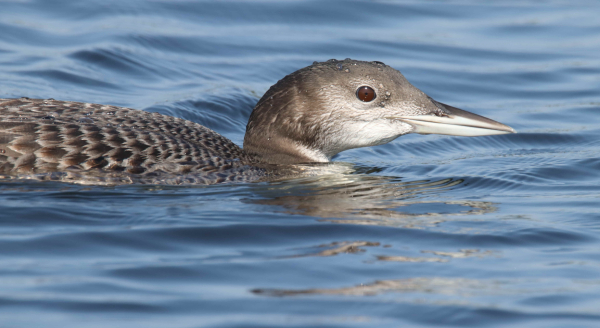
After a month since the last loon cruise, it was especially exciting to see the young Common Loon fully feathered and still showing a tan hue to its plumage.
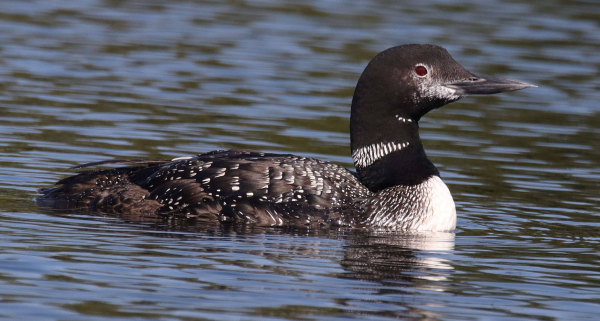
The adult loon was now in the midst of its post-nesting molt, providing some interesting photos to compare with images taken earlier this summer.
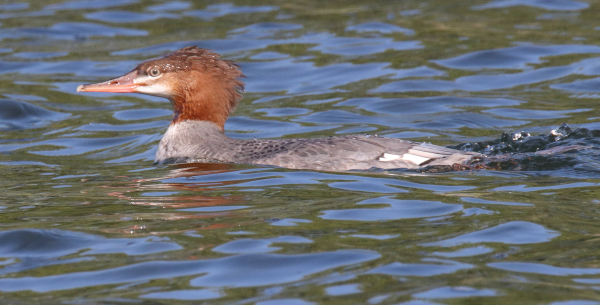
One of the brood of 5 young Common Mergansers fishing cooperatively on a shallow shoreline at Pelican Lake.
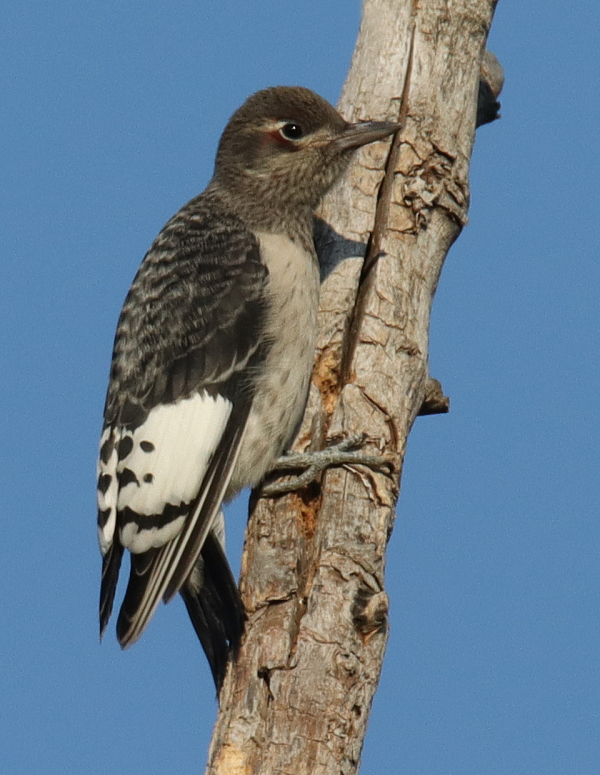
A new view of a gray-colored Red-headed Woodpecker fledgling, recently independent from the nesting cavity and flying, perching, and climbing branches well.
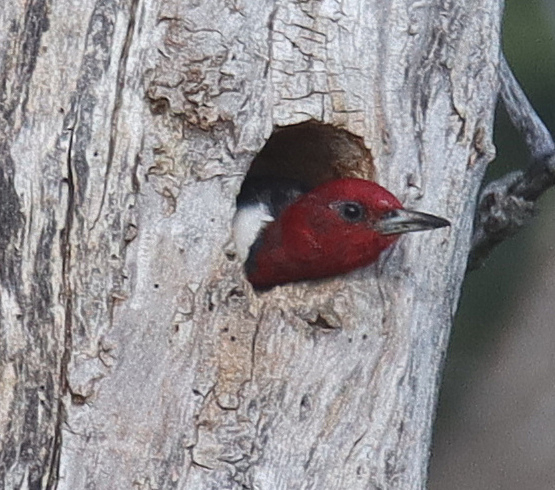
An adult Red-headed Woodpecker took a moth inside the nesting cavity, then paused for a few moments in the entrance before flying to a perch to resume hunting.
|
Any apprehension about whether the young loon would be present faded quickly as I observed it near an adult with binoculars – after my great friend Andy sighted the adult from his captain’s chair on the pontoon we have used to access pairs of Common Loons at Little Pelican Lake in west-central Minnesota. To my delight, just minutes after pushing off from Andy’s dock we were photographing the now fully feathered fledgling loon and the molting adult. The weather was beautiful with blue-sky sunshine and the surrounding green woodland provided another memorable hour of observations while photographing.
It was exciting to see the young loon fully feathered, especially because it has an especially attractive tan hue to its plumage. Throughout the time we observed the loons, the fledgling was very actively fishing, staying below the water surface for impressive periods of time, while the adult didn’t get into the diving action until the last 20 minutes and thereafter, when both loons were very actively diving. For more information about this thrilling loon cruise, including biological insights and photo information, with more photographs of the loons, see the Bird Photography feature in this issue.
After leaving the young loon and adult, we checked for the second pair of loons we’ve been monitoring, but didn’t find any other loons on Little Pelican. At that point, Andy suggested we check out the east side of adjacent Pelican Lake, navigating the little Pelican River that flows between the 2 lakes and beyond. A fun sighting along the river was a Great Blue Heron standing on a beaver lodge with Andy’s lake home in the background. On big Pelican Lake, we initially saw birds on the water, and hoped some might be loons, but it became evident that most were Ring-billed Gulls – except one. It was a large Common Loon, probably a male, with a similar molt sequence showing as the first adult we photographed.
Next we motored quietly along the northeast shoreline of Pelican Lake and found a fully grown brood of Common Mergansers that Andy especially enjoyed watching as they were cooperatively fishing. Spaced about 4 feet apart, they would suddenly paddle frantically forward in tandem to drive small fish before them, then dive into the shallow water to try to catch fish. Sometimes there would be a bit of a scramble when one young merganser caught a fish and adjacent mergansers tried to steal it away before it was swallowed. We were also surprised to see Andy’s friend Craig while he was fishing, and swapped a few stories with him – small world on a big lake.
Other birds we identified during our loon cruise included Belted Kingfishers, Great Blue Herons, Great Egrets, Northern Flickers, Hairy Woodpeckers, Black-capped Chickadees, Ring-billed Gulls, and the Common Mergansers. I was surprised we didn’t see any Osprey, which may already have vacated the area to migrate, although I did see an adult Bald Eagle as I drove to the lake. I also saw 2 separate pairs of Trumpeter Swans, one pair with a gray-plumaged cygnet.
Woodpecker Excitement
After that wild and wonderful loon expedition, a local birding drive Friday afternoon was a bit refrained, until I checked in on the Red-headed Woodpecker nesting territory. Since the adults showed me their nesting cavity the previous Sunday when they brought food to a soon to fledge nestling, I checked back on the site, but didn’t see any more of the young woodpecker; and only once did a see an adult. That changed Friday though, as there was a flurry of action during my 45 minutes of observations, with both adults actively hunting large insects.
Again, I didn’t see any action at the nesting cavity entrance, suggesting all the more that the nestling fledged soon after I observed it. But suddenly, a gray-headed fledgling flew to the dead tree where the adults often perched to hunt insects, but it only alighted a moment before reversing into the cover of trees. Even so, it was a breakthrough just to see the fledgling in action. I also saw the fledgling from quite a distance (or was it a second fledgling) as it flew to a dead tree where one of the adults was perched. I took a couple long-distance documentary photos of the young woodpecker, and hoped for a closer photo opportunity.
That’s when an interesting action happened: One of the adult Red-heads flew to the nesting cavity with a moth in its beak, entered the cavity, then peered out of the cavity hole similar to how the nestling did before. Was there another nestling inside the cavity? Or was the adult placing an insect into the cavity for a fledgling to find? When the adult left the cavity, it flew to the favorite dead tree near the rural road, providing a photo op, and then it happened: A fledgling landed on the same tree in full sight, providing an introductory photo op, and it stayed and repositioned to offer a couple different looks from the side and back – what fun.
Local Migrants
Sunday there was a flock of about a dozen Chipping Sparrows in my backyard, along with 2 Northern Flickers. And Monday I appreciated 5 Northern Flickers foraging for ants on the grass outside my bay windows beyond my feeding station. The best observations of other migrants happened as I observed the Red-headed Woodpeckers Friday, including sightings of the first Yellow-rumped Warbler, Orange-crowned Warblers, Warbling Vireos, a Gray Catbird, and Lark Sparrows. While it’s harder to tell when birds have migrated away, it is all too obvious that Ruby-throated Hummingbirds have migrated, along with Eastern and Western Kingbirds, Common Nighthawks, Upland Sandpipers, Orchard Orioles, and others.
In addition to the local changes in birdlife, the season has clearly started to change since Labor Day, with cooler temperatures and even a few yellow leaves beginning to show. It’s exciting as fall begins to dominate more and more as the days progress and more birds migrate into and out of the area. There are wonderful times ahead, so keep your binoculars and camera close at hand, and try to make some extra time for birding – Enjoy!
Article and photos by Paul Konrad
Share your bird sightings and photographs at editorstbw2@gmail.com